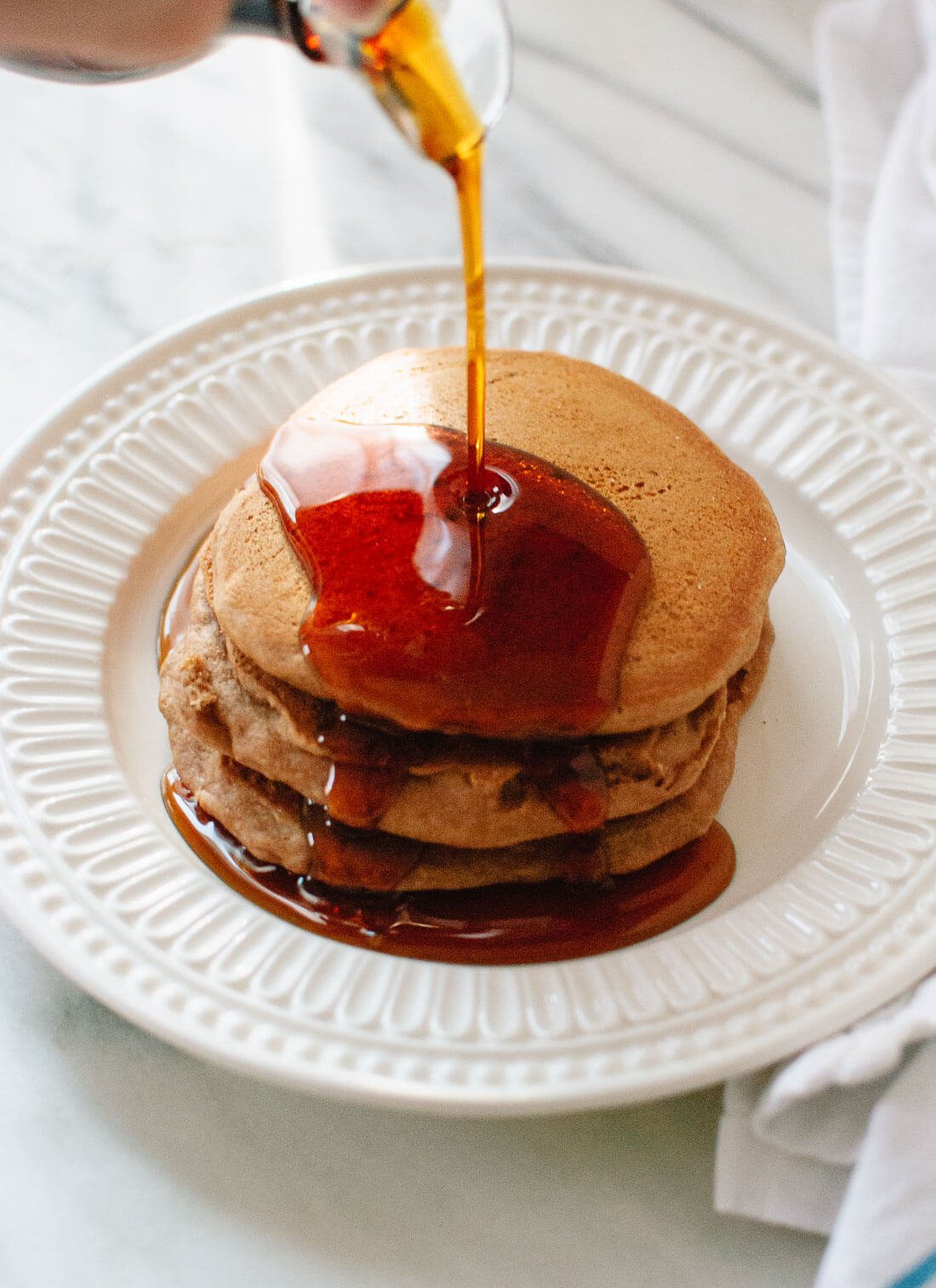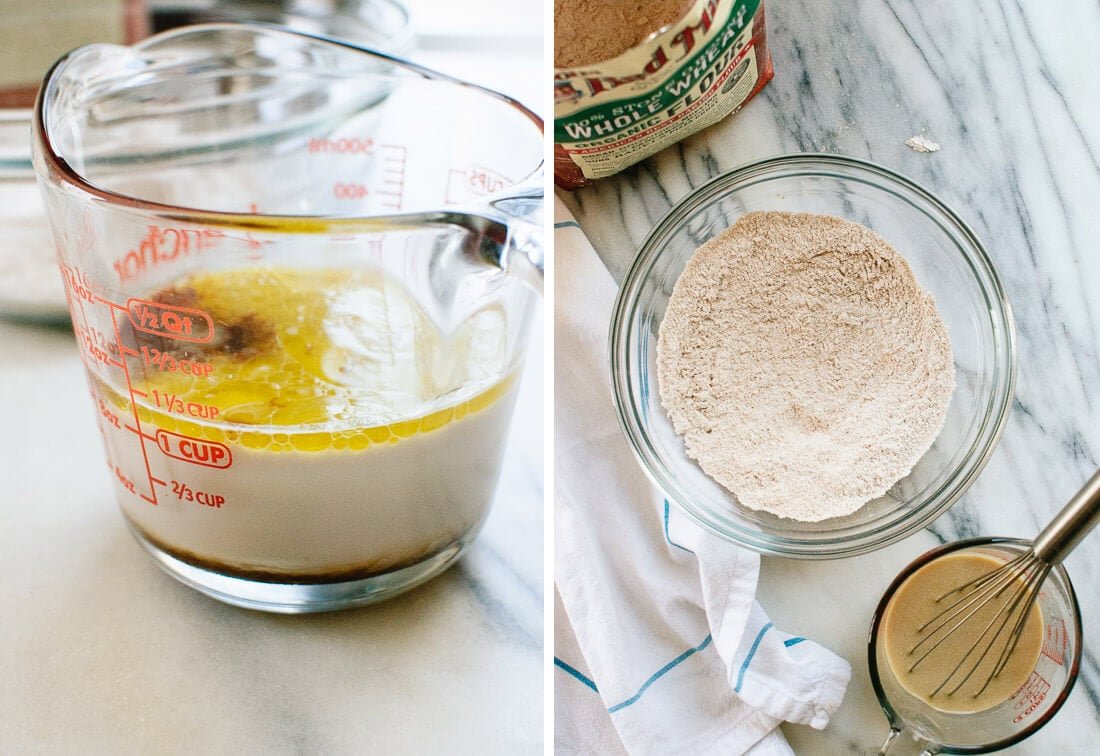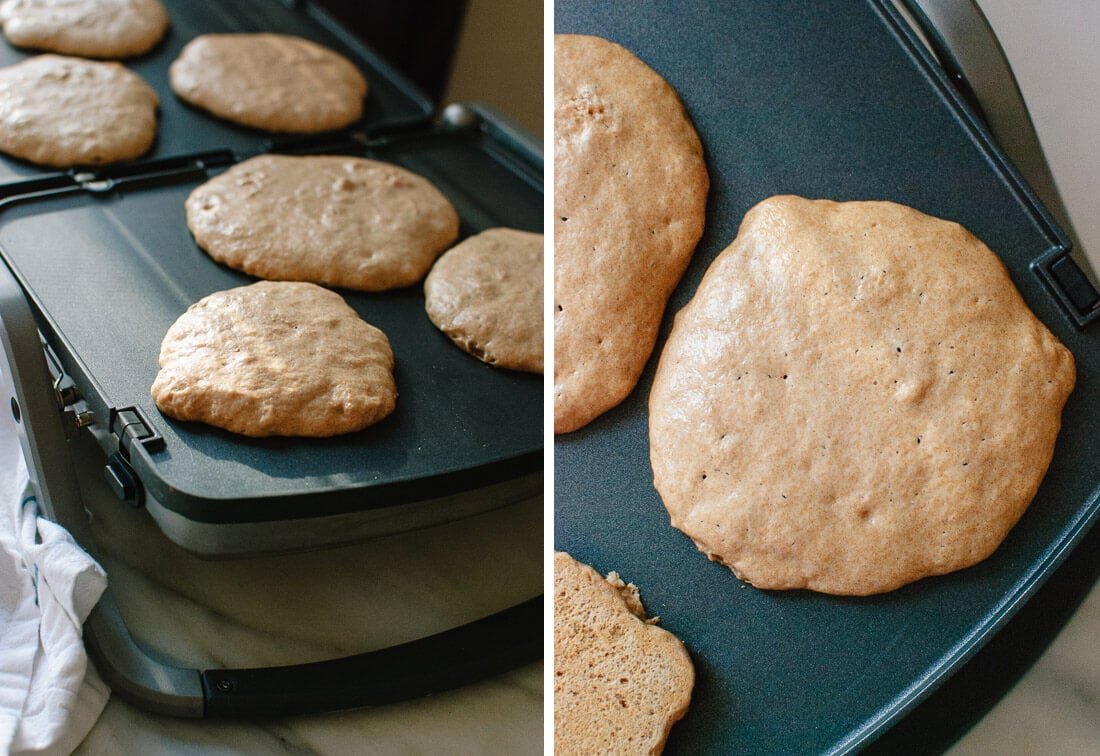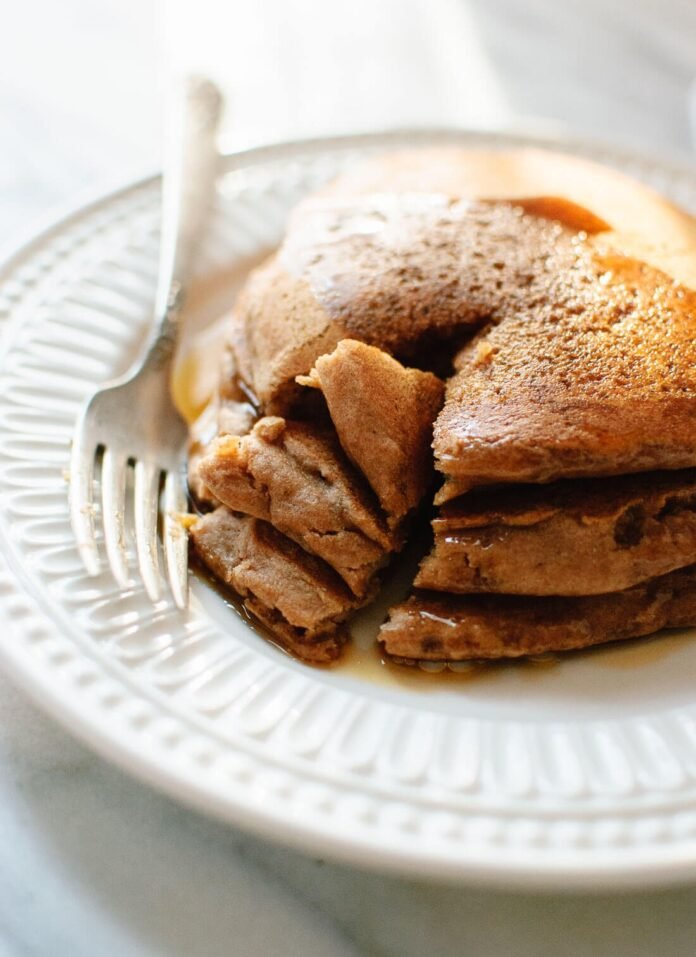
I’ve been laying low since I got home after a month of being away. Hibernating, if you will. Reveling in the quiet and making coffee without worrying about waking someone. Making pancakes over and over. Spending lots of quality time with my dog Cookie, the pancake thief.
It’s been lovely. My pancake endeavors have paid off, too. I realized the other day that I don’t have a basic pancake recipe on the blog, so here we are. Meet my new favorite pancake recipe. It’s easy, healthy and vegan, to boot!

How to Make the Best Vegan Pancakes
Basically, I reduced my gingerbread pancake recipe to its most essential formula, then I traded almond milk for cow’s milk and olive oil (or coconut oil) for the butter. I was concerned I’d taste olive oil in the finished product, but I really can’t! Coconut oil works as well, but it solidifies on contact with cold ingredients, so olive oil is the easier choice.
I tried a “buttermilk” version as well, with almond milk combined with a tablespoon of vinegar and lesser amounts of baking soda and baking powder. Even with the vinegar to react with the baking soda, the pancakes tasted terribly bitter. I’m still mystified. I scratched the buttermilk idea and carried on with one tablespoon baking powder as the leavener, which works great.
I omitted the eggs completely, surprisingly without any downsides. Just to be sure, I tried a version with flaxseed to replace the egg, but it didn’t make any difference. The batter gets nice and bubbly thanks to the baking powder, then it fluffs up on contact with the hot cooking surface like flatbreads typically do.
Without that eggy flavor, the remaining ingredients get to shine through. As such, this vegan pancake recipe produces remarkably delicious pancakes.

Whole Wheat Flour Tips
Bob’s Red Mill sent me their organic whole wheat flour, which imparts a lovely, lightly nutty flavor. Bonus? Since it’s higher in fiber and protein than all-purpose flour, these pancakes are more likely to stick with you until lunch.
Speaking of whole wheat flour, if yours tastes bitter, your flour has gone bad! Whole wheat flour is not inherently bitter, but because it contains all of the good-for-you natural oils present in wheat, it can go bad more quickly than processed flours. For best longevity, buy quality flour and store it in an air-tight container in a cool, dark place, like the refrigerator or a cabinet.

Please let me know how this recipe turns out for you in the comments!
If you love this recipe, be sure to check out the two pancake recipes in my cookbook, which both have vegan options. Looking for more vegan breakfast recipes? Here are a few of my favorites:



Watch How to Make Vegan Pancakes

Simple Vegan Pancakes
These easy vegan pancakes are my favorite basic pancakes! Who knew that eggless, whole grain pancakes could be so fluffy?! Feel free to throw in some add-ins like blueberries or chocolate chips, if you’re so inclined. Recipe yields 6 modestly-sized pancakes (perfect for 2 servings), so multiply as necessary.
- In a mixing bowl, whisk together the flour, baking powder and salt. In a 2-cup liquid measuring cup or another mixing bowl, whisk together the milk, oil, maple syrup and vanilla extract until thoroughly blended. (If your coconut oil solidifies on contact with the cold milk, gently warm it in the microwave just until it liquifies again.)
- Pour the liquid mixture into the dry mixture. Stir until combined, so only a few lumps remain (don’t over-mix or your pancakes will be tough!). If you’d like to mix in any totally optional add-ins (like chocolate chips or blueberries), gently fold them in now. Let the batter rest for 5 minutes so your pancakes will be nice and fluffy.
- Meanwhile, if you’ll be using an electric skillet, heat it to 350 degrees Fahrenheit. Otherwise, heat a heavy cast iron skillet or nonstick griddle over medium-low heat. You’re ready to start cooking your pancakes once the surface of the pan is hot enough that a drop of water sizzles on contact.
- If necessary, lightly oil the cooking surface with additional oil or cooking spray (I don’t oil the surface of my non-stick griddle and my pancakes turned out great).
- Using a ¼-cup measure, scoop the batter onto the warm skillet. Cook for 2 to 3 minutes until small bubbles form on the surface of the pancakes (you’ll know it’s ready to flip when about ½-inch of the perimeter is matte instead of glossy), and flip. Cook on the opposite sides for 1 to 2 minutes, or until golden brown.
- Repeat the process with the remaining batter, adding more oil as needed. You may need to adjust the heat up or down at this point. Serve the pancakes immediately or keep warm in a 200 degree Fahrenheit oven.
Notes
Adapted from my gingerbread pancake recipe.
*Flour options: All-purpose flour should also work fine here.
*Make it gluten-free: Readers report that Bob’s Red Mill’s gluten-free all-purpose flour works great.
Leftover pancakes? Pancakes make great leftovers! Store them in the refrigerator for up to 5 days, or freeze them for months. To warm, wrap a short stack of pancakes loosely in a paper towel and gently reheat in the microwave until warmed through, flipping and re-wrapping the stack halfway through.
Make-ahead option? I don’t recommend mixing pancake batter and storing it in the refrigerator overnight. You will have better luck mixing the dry ingredients separately from the wet ingredients, as directed in step 1, then storing those two components separately (store the wet mixture in the fridge). When you’re ready to make pancakes, begin with step 2. This technique will work better if you use olive oil, since coconut oil solidifies when chilled.
Nutrition
The information shown is an estimate provided by an online nutrition calculator. It should not be considered a substitute for a professional nutritionist’s advice. See our full nutrition disclosure here.






